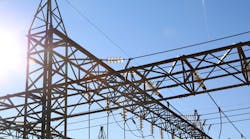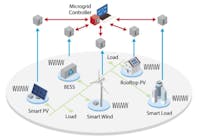Utility operators face a rapidly changing operational and business climate due to increasing regulatory compliance requirements and demands for security. In addition, they need to be able to consolidate and manage the growing variety of information and communications that form the “central nervous system” of power delivery.
At the same time, utility operators must not only maintain, but also increase the reliability of the power delivery system. Utility operators also must plan for new operations such as the integration of renewable energy sources to meet legal and regulatory mandates. All of these challenges must be met in the extremely demanding physical environment of the power utility substation.
Regardless of geographic location, the strategy utility companies have been rapidly turning to is the “smart grid,” an intelligent communications infrastructure that can efficiently integrate all supply and demand elements connected to the electric grid.
The world’s most advanced companies and government agencies are now focused on using new technologies to create lasting change. The entire ecosystem – from power gen through transmission/distribution to end-user -- can be made smarter, faster, more agile, resilient -- and most importantly, more secure. New technologies that are now available, from generation to consumption, are enabling the electric grid to increasingly become all of the following:
- Observable - Full determination of grid state means deep situational awareness.
- Automated - Leveraging pervasive sensing the ability to automatically respond to conditions and events beyond traditional protection and controls will become mainstream allowing more refined control of an increasingly diverse and stochastic electric system.
- Intelligent - Global energy networks are increasingly evolving, and will continue to do over the coming years, in ways that help to enable a large diversity of energy supply and a more responsive load.
- Sophisticated – Analytics, coupled with advanced distributed control schemes, enable adaptive tele-protection and intelligent operational systems to manage inherently unstable systems.
- Transactive - As the Internet of Things converges with the electrification of everything, hundreds of millions of energy-smart devices can interact with energy markets, leading to trillions of microtransactions.
A growing number of utilities are investing in the creation of end-to-end, resilient, and secure communication infrastructures. The aim is to support and manage their smart grid deployments. European-based utilities are among those undertaking these moves.
Firstly, how to define "smart grid?" A smart grid exists wherever the electricity delivery system, from point of generation to point of consumption, is integrated with communications and information technology – and where it is delivering enhanced grid operations, better customer services, and positive environmental benefits.
For a smart grid to work well, it requires some key working elements that can be synchronized:
- Interoperability across multiple vendors.
- Protection of data & system integrity.
- Support for many types of media.
- Rapid collection and analysis of massive quantities of data.
- Connectivity to and from millions of devices.
- Rapid response to “bursty” event–related message data.
- Convergence of multiple existing networks.
A smart grid enhances both power distribution and power management by providing distributed intelligence -- and enabling a measure of control. The end result is more cost-efficient delivery of power, based on true demand.
Smart meters are deployed precisely because they can provide the basis for real-time measurement of customer demand. Integrated networking technologies and security features bring that information securely onto the grid -- forming a backhaul communication network.
Demand information, since it is so vital, is shared with the local utility, which in turn can leverage local generation sources (or power storage) to meet demand fluctuations. Operation analytics tools make it possible for these same utilities to better manage the network, and to integrate distributed generation sources.
Importantly, home automation controls and commercial facility automation can both be connected to this same network. They can be designed in such a way that they respond to demand management requests, which become especially important as the load on the grid increases.
As more granular information is shared between and among the local and primary utility operation centers, power generation needs can be more effectively managed – which results in reduced costs for electricity.
The sharing of demand and supply information among utility providers and with their data centers (ideally operated as a ‘federation’) allows decision-making to be distributed throughout the network. This provides resilience to attacks on the grid, and it enables a faster response to prevent outages.
Such deployments can utilize the network as the platform to intelligently bring together disparate sources of a smart-utility’s information.
Leveraging a broad set of technologies, solutions, services and partners, the smartest utilities empower smart grid initiatives with advanced communications networks. When executed well, the result is to create space for new business models and new operational models, enhancing physical security and cyber security, while providing energy consumers a wide range of benefits.
The reasons why different countries invest in smart grids are as varied as their national geographies and political systems are different:
United States – During the Obama years, the American Recovery and Revitalization Act (ARRA) provided for a total of $4.5B for smart grid initiatives. Of that, $3.9B was administered by the US Dept of Energy (DoE) for investment and research and development programs. The remaining $600M was for worker training and interoperability work undertaken by the US National Institute of Standards and Technologies (NIST). During the two Trump years the US Administration has dropped the ball, doing little in practical terms -- although the words coming from the DOE have been favorably inclined towards smart grid.
China - The State Grid Corp of China (SGCC) has been deploying extensive fiber-optic networking throughout China high-voltage substations. This network now totals many millions of kilometers of fiber-optic channels. According to one SGCC spokesperson, there will be “a lot of business opportunities for smart grid relevant industries,” such as the firms supplying smart metering systems, power storage devices, telecommunication devices, and software.
Australia - The national government announced plans to invest large sums – in one instance committing hundreds of millions of dollars, in partnership with the energy sector, with all of it focused on developing a national energy efficiency initiative. This initiative supporting the installation of Australia's first commercial-scale smart grid. The national government, along with some of the key state governments, now have a variety of programs underway – with millions of smart meters rolling out to homes and businesses.
During the 2019 calendar year, some national governments and regional agencies will act in ways that further the smart grid. The hope is that the rest of the world will follow their lead.


